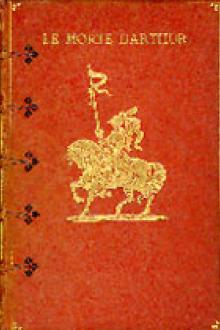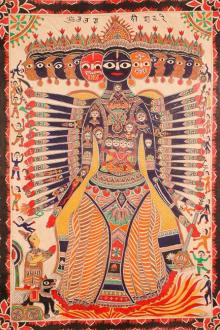Olaf the Glorious: A Story of the Viking Age, Robert Leighton [best ebook reader .TXT] 📗

- Author: Robert Leighton
Book online «Olaf the Glorious: A Story of the Viking Age, Robert Leighton [best ebook reader .TXT] 📗». Author Robert Leighton
"Why, then, should I care to wed with thee?" he cried; "thou withered old heathen jade!"
With these taunting words on his lips he turned and strode from the chamber. But while the wooden stairway was still creaking under his tread, Queen Sigrid called after him in bitterest anger:
"Go, then, O proud and stubborn king. Go where you will. But remember this, that the insult you have offered me and the blow you have struck me shall be your death!"
So Olaf departed, ere yet he had broken bread, and he went north into Viken, while Queen Sigrid the Haughty went east into Sweden.
King Sweyn Forkbeard of Denmark had by this time regained full possession of his kingdom, and was contemplating an invasion of England which should be more complete and decisive than the attempt which he had made in company with the viking whom he had known as Ole the Esthonian. Sweyn had now, of course, discovered that this man Ole and King Olaf of Norway were one and the same person, and he began to be very jealous of the glory that was gathering about Olaf's name. A new cause for jealousy had now arisen.
Sweyn, it will be remembered, had married the Princess Gunnhild, daughter of Burislaf, King of the Wends. But in these days even now told of it befell that Queen Gunnhild was stricken with an illness and died. King Sweyn, ever ambitious of winning great dominion, had a mind to take unto himself a new wife in the person of Queen Sigrid of Sweden. He was on the point of setting out to woo her when he heard by chance that King Olaf Triggvison was already bent upon a similar journey. Envy and jealousy and bitter hatred welled up in Sweyn's breast against his rival, and he swore by Thor's hammer that sooner or later he would lower King Olaf to the dust.
But in good time King Sweyn heard of the quarrel that had befallen between Queen Sigrid and her young Norwegian suitor. So he at once fared north into Sweden to essay his own fortune with the haughty queen. He gained a ready favour with Sigrid by speaking all manner of false and malicious scandal against the man whom she had so lately rejected. Sigrid probably saw that by marrying the King of Denmark she might the more easily accomplish her vengeance upon Olaf Triggvison. She therefore accepted Forkbeard's proposals, and they were wedded in accordance with the rites and customs of their pagan faith.
Earl Erik, the son of the late Earl Hakon, was at this time the guest and friend of Sigrid's son, Olaf the Swede King; and these three--King Sweyn Forkbeard of Denmark, King Olaf of Sweden, and Earl Erik of Lade--had each a private cause of enmity against Olaf Triggvison. It was they who, two years afterwards, united their forces in the great sea fight in which Olaf the Glorious lost his life.
CHAPTER XVIII: THE "LONG SERPENT".King Olaf had now ruled over Norway for three years. In that brief time he had done more for the country than any king who had gone before him. He had succeeded in establishing Christianity--not very thoroughly, it is true, for during the rest of his reign, and for long enough afterwards, there was plenty of heathenism in Norway; but he did all that he could to make men Christians, as far as he knew how himself, and, by his own example of a pure and upright life, he did much to deepen the feeling that, even in a social sense, the Christian religion' offered advantages which had never before been enjoyed in the land. It was noticed almost immediately that there was less bloodshed among the people than formerly, and that the peasants lived in greater security. The doctrine of peace upon earth was set forth as one of the first principles of Olaf's mission, and he was never tired of showing that, while Odin and Thor took pleasure in bloodshed and rejoiced in war, Christ the White was a lover of peace, and accorded no merit to the manslayer.
Olaf made it a law throughout his realm that all men should keep the Sabbath holy, that they should always fast on Fridays, and that they should teach their children the Ten Commandments. He could not hope that grownup people, who had all their lives been accustomed to worship graven images, would all at once become fervent and devout Christians; but he clearly saw the importance of bringing up all the children to a full knowledge of the Christian faith, and accordingly he bade his priests give constant care to the education of the young.
What King Olaf achieved in Norway he achieved also in the outlying parts of his dominions. He sent priests into the lands of the Laps and Fins. It has been told how he sent his priest Thrangbrand to Iceland. He also sent missions to the Orkney Islands, to the Shetlands, and the Faroes, and even to so distant a country as Greenland. All these lands were converted to Christianity during Olaf's brief reign.
But it was not in religious matters alone that Olaf Triggvison exercised his wisdom and his rule. He encouraged fisheries and husbandry and handicrafts, and men who had given up their lives to warfare and vikingry now occupied themselves with useful arts and industries. Himself a rare sailor, he loved all seamen and shipmen and shipbuilders, and so that these might have work to do he encouraged commerce with the lands over sea--with England and Scotland and Ireland, with Russia, Wendland, Friesland, Flanders, and France.
When he had been in England he had learned something of the good laws established in that country by King Alfred the Great. He strove to introduce many of these laws into his own kingdom. Like Alfred the Great, King Olaf recognized the value of a strong navy, and, so soon as he had assured himself of the goodwill of his subjects, he levied taxes upon them, and set about the work of building ships.
The great dragonship which he had taken as a prize of war from Rand the Wizard was the largest and finest vessel in the Norwegian seas at this time. The king determined to have a much larger and finer ship built, one which should surpass in splendour and equipment every vessel that had been launched in Norway or any other land throughout the ages. On the banks of the river Nid, at the place where he had built the town of Nidaros, a great forest of pine trees had been cleared, and there was timber in plenty ready at hand. There had been two most fruitful seasons, with good crops, and the country was rich. Olaf himself possessed more wealth than any monarch in all Scandinavia, and also he was fortunate in having about him a number of men who were highly skilled in the work of designing and building ships. So he had a shipyard prepared under the cliffs of Lade, and he appointed a man named Thorberg Shafting to be his master builder.
Rand's dragonship, which was named the Serpent, was taken as a model of the new ship that was to be made, but all her measurements were exactly doubled, for the new craft was to be twice as long in the keel, twice as broad in the beam, and twice as great in the scantling. Olaf himself helped at the work, and laboured as hard as any other two men. Whenever any difficulty arose he was there to set it right, and all knew that every part of the work must be well done, that every piece of timber must be free from rot, and every nail and rivet made of the best metal or the king would discover the fault and have it undone.
Many men were in the shipyard, some to hew timbers with their heavy axes, some to fashion iron bolts and bars, and others to spin the shining flax into the ropes that were to form the rigging. Burly blacksmiths stood at the roaring forge, wielding huge hammers; sawyers worked in the pits, making the stout beams and ribs and cutting great trunks into thin planks. Black cauldrons of boiling tar smoked and bubbled over the fires. The clattering of hammers, the rasping of saws, the whirring of wheels, and the clamour of men's voices sounded from earliest morning until the setting of the sun; and the work went on apace all day and every day, saving on Sunday, when no man was allowed to touch a nail or lift a hammer.
On a certain morning in the midsummer, King Olaf was down in the shipyard. He wore his coarsest and oldest clothes; his thick, strong arms were bared above the elbows, and his hardened hands were smutched with tar and nail rust. His head was shielded from the hot sun by a little cloth cap that was torn in the crown, and his long hair and his broad back and shoulders were besprinkled with sawdust. Save for his greater tallness and strength he looked not very different from any of the workmen about him; and indeed Kolbiorn Stallare, who stood near him in courtly apparel, might well have been mistaken for the king and the king for the servant.
Olaf had paused in his work, and was talking with Kolbiorn concerning some matter of state. As he stood thus, leaning with one elbow on the long handle of his great sledgehammer, he saw young Einar Eindridson coming towards him, followed by a woman. The woman seemed to be of middle age, and she looked weary with travel. As she came nearer, her eyes rested upon Kolbiorn as though she wished to speak with him.
"Go to her," said the king. And Kolbiorn left Olaf's side and went to meet her.
"Long have I searched for you, King Olaf," said she, drawing back the cloak from her head, and letting the sun shine full upon her face. "But I have found you at last, and now I crave your help for the mercy of God!"
"You make a mistake, lady," said Kolbiorn; "I am not King Olaf, but only his servant. Yonder is the king at work among his shipwrights. But if you would speak with him I will take you to him, for I see that you are in distress."
So he took her to where Olaf was, and when she stood near him she looked at him in disbelief, taking him to be but a workman. But when the king laid down his hammer and stood up at his full height and uncovered his head, she saw that he was no ordinary man. Her eyes went to his bare arm, where there still remained the mark branded there in the days of his bondage in Esthonia.
"By that token do I know you, O king," said she. "But you are taller and stronger than when last we met."
"In what land and in whose company was that meeting?" asked King Olaf. "Methinks I have indeed seen you before, but in what circumstances and at what time I do not call to mind."
"We met long years ago," said she. "First in Wendland, when you were a guest at the court of King Burislaf; and again when we sat side by side at the inheritance feast of King Sweyn of Denmark. My name is Thyra. Harald Bluetooth, king of Denmark, was my father, and I am the sister of King Sweyn of the Forked beard, who now reigns over all Denmark, and who has lately wedded with Queen Sigrid of Sweden."
"Right well do I now remember you," returned Olaf. "And well do I mind that, at that same feast in Denmark, you scorned me because I had been a





Comments (0)